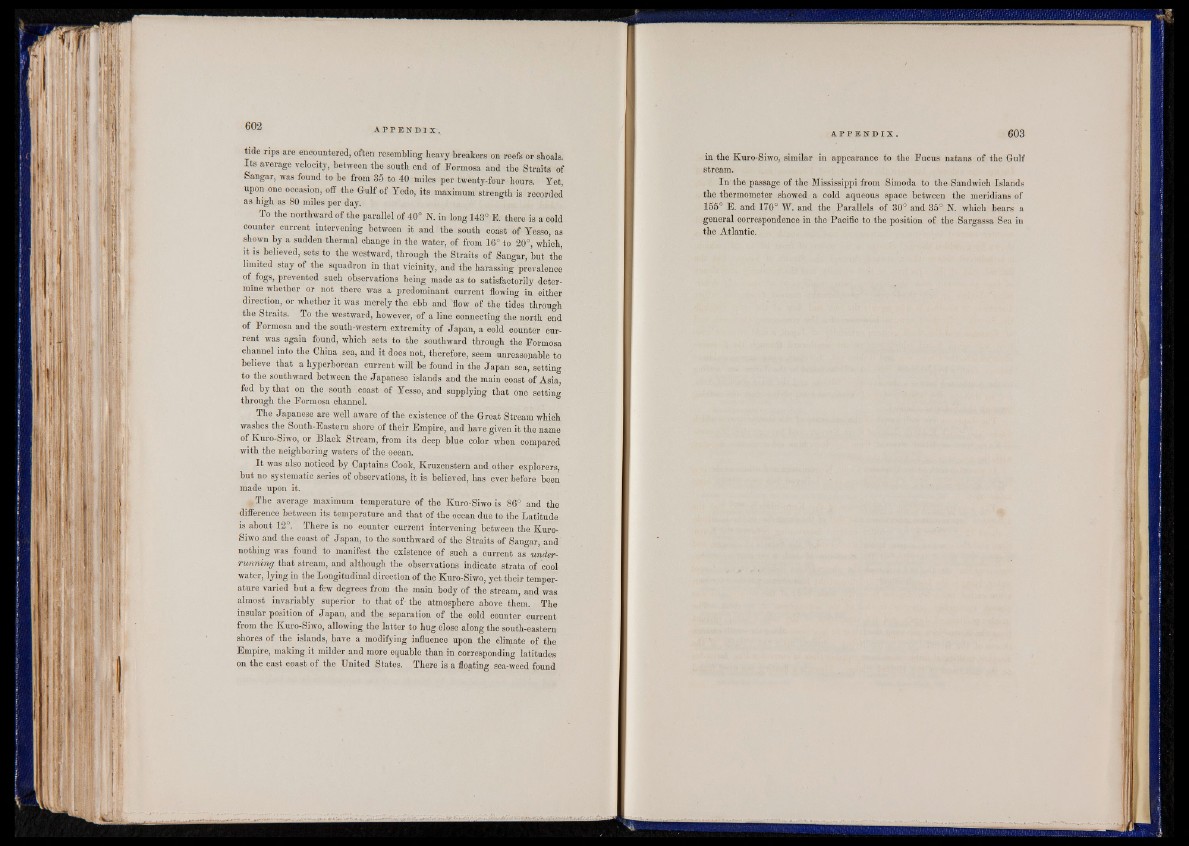
tide rips are encountered, often resembling heavy breakers on reefs or shoals.
Its average velocity, between the south end of Formosa and the Straits of
Sangar, was found to be from 35 to 40 miles per twenty-four hours. Yet,
upon one occasion, off the Gulf of Yedo, its maximum strength is recorded
as high as 80 miles per day.
To the northward of the parallel of 40° N. in long 143° E. there is a cold
counter current intervening between it and the south coast of Yesso, as
shown by a sudden thermal change in the water, of from 16° to 20°, which,
it is believed, sets to the westward, through the Straits of Sangar, but thé
limited stay of the squadron in that vicinity, and the harassing prevalence
of fogs, prevented such observations being made as to satisfactorily determine
whether or not there was a predominant current flowing in either
direction, or whether it was merely the ebb and flow of the tides through
the Straits. To the westward, however, of a line connecting the north end
of Formosa and the south-western extremity of Japan, a cold counter current
was again found, which sets to the southward through the Formosa
channel into the China sea, and it does not, therefore, seem unreasonable to
believe that a hyperborean current will be found in the Japan sea, setting
to the southward between the Japanese islands and the main coast of Asia,
fed by that on the south coast of Yesso, and supplying that one setting
through the Formosa channel.
The Japanese are well aware of the existence , of the Great Stream which
washes the South-Eastern shore of their Empire, and have given it the name
of Kuro-Siwo, or Elack Stream, from its deep blue color when compared
with the neighboring waters of the ocean.
I t was also noticed by Captains Cook, Kruzenstem and other explorers,
but no systematic series of observations, it is believed, has ever before been
made upon it.
.. The average maximum temperature of the Kuro-Siwo is 86° and the
difference between its temperature and that of the ocean due to the Latitude
is about 12°. There is no counter current intervening between the Kuro-
Siwo and the coast of Japan, to the southward of the Straits of Sangar, and
nothing was found to manifest the existence of such a current as under-
running that stream, and although the observations indicate strata of cool
water, lying in the Longitudinal direction of the Kuro-Siwo, yet their temperature
varied but a few degrees from the main body of the stream, and was
almost invariably superior to that of- the atmosphere above them. The
insular position of Japan, and the separation of the cold counter current
from the Kuro-Siwo, allowing the latter to hug close along the south-eastern
shores of the islands, have a modifying influence upon the clirpate of the
Empire, making it milder and more equable than in corresponding latitudes
on the east coast of the United States. There is a floating sea-weed found
in the Kuro-Siwo, similar in appearance to the Fucus natans of the Gulf
stream.
In the passage of the Mississippi from Simoda to the Sandwich Islands
the thermometer showed a cold aqueous space between the meridians of
155° E. and 170° W. and the Parallels of 30° and 35° N. which bears a
general correspondence in the Pacific to the position of the Sargassa Sea in
the Atlantic.